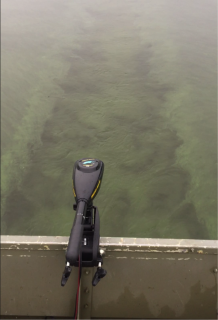By Jack Lindauer and Jeffrey Tepper, Geology Department, University of Puget Sound
The frequency of hazardous algal blooms (HABs) is increasing among lakes in the Pacific Northwest, as it is worldwide. While it is generally accepted that climate change and anthropogenic nutrient loading contribute to this increase, the specific driving forces can vary from one lake to the next. In this article we describe ongoing work at two public lakes in Pierce County,Washington, where, despite their close proximity and similar geologic settings, the causes of HABs appear to differ.
Waughop and Spanaway Lakes are just over six miles apart; both are adjacent to public parks, both are dominantly groundwater-fed, and both originated as kettles – depressions that formed ~14,000 years ago by the melting of ice blocks that were buried in sediment deposited during glacial retreat.
Waughop is smaller and shallower than Spanaway (12 hectares, 3m deep versus 100 hectares, 7.5m deep) and until the 1960’s was used as an agricultural waste pond. Consequently, the top 50 cm of sediment there is organic-rich, with very high phosphorous levels (avg. > 1200 ppm). Sequential extraction studies indicate ~40% of this P is stored as Fe-phosphate compounds, and during the summer and early fall, when bottom waters are reducing, these compounds can dissolve, releasing P into the hypolimnion.
Because Waughop is shallow, windy or stormy weather can trigger short-lived mixing events that deliver nutrient-rich bottom water to the surface, even during the summer. The result of this year-round internal loading process is exceptionally high productivity and high microcystin concentrations. Since 2007, microcystin levels at Waughop have exceeded the method detection limit (MDL) on 140 of 196 sampling dates, including some dates in the winter.
At first glance the situation at Spanaway Lake appears similar. HABs here have occurred sporadically (MDL exceeded 47 of 110 times), but with increasing frequency. Because it is a popular recreation destination, Spanaway was selected for remediation by Pierce County.
The effort began with a 2016 study of the lake’s nutrient cycle,which suggested that bottom sediment was the main source of the P leading to algal blooms. As an extension of that work, we conducted bimonthly water column monitoring from May to October this year to document the development of thermal and chemical stratification, mixing events, and growth of algae.
Two unexpected findings emerged from this monitoring. The first was that although bottom waters became anoxic by August, P contents in the hypolimnion remained low, suggesting that minimal P was released from the sediment. A second surprise was that there were no transient mixing events during the summer months; once thermal and chemical stratification was established in May, it persisted until October.
These findings suggest that prolific algal growth at Spanaway (Fig 1), which occurred by August, was not driven by internal cycling of P released from the sediment, but was more likely caused by the influx of nutrient-rich groundwater (which has been documented in some local monitoring wells). Two factors may account for the apparent lack of internal P cycling at Spanaway Lake. One is its greater depth, which inhibits mixing during times of thermal stratification, and the other is the high iron and manganese content of its sediment, which serves to stabilize strengite (FePO4-2H2O) and Mn-PO4, both of which sequester P.
Additional study will be required to quantify nutrient cycling at Spanaway Lake, but our results highlight the importance of: (1) frequent water column monitoring over the full summer-fall season, and (2) complete water analyses that allow for calculation of mineral saturation. Similar studies may be beneficial at other lakes where choosing the appropriate remediation plan will require knowledge of the relative importance of internal vs external nutrient loading.










